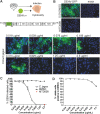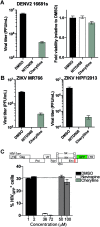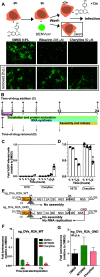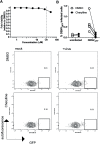Amaryllidaceae Alkaloid Cherylline Inhibits the Replication of Dengue and Zika Viruses
- PMID: 34152811
- PMCID: PMC8370201
- DOI: 10.1128/AAC.00398-21
Amaryllidaceae Alkaloid Cherylline Inhibits the Replication of Dengue and Zika Viruses
Abstract
Dengue fever, caused by dengue virus (DENV), is the most prevalent arthropod-borne viral disease and is endemic in many tropical and subtropical parts of the world, with an increasing incidence in temperate regions. The closely related flavivirus Zika virus (ZIKV) can be transmitted vertically in utero and causes congenital Zika syndrome and other birth defects. In adults, ZIKV is associated with Guillain-Barré syndrome. There are no approved antiviral therapies against either virus. Effective antiviral compounds are urgently needed. Amaryllidaceae alkaloids (AAs) are a specific class of nitrogen-containing compounds produced by plants of the Amaryllidaceae family with numerous biological activities. Recently, the AA lycorine was shown to present strong antiflaviviral properties. Previously, we demonstrated that Crinum jagus contained lycorine and several alkaloids of the cherylline, crinine, and galanthamine types with unknown antiviral potential. In this study, we explored their biological activities. We show that C. jagus crude alkaloid extract inhibited DENV infection. Among the purified AAs, cherylline efficiently inhibited both DENV (50% effective concentration [EC50], 8.8 μM) and ZIKV replication (EC50, 20.3 μM) but had no effect on HIV-1 infection. Time-of-drug-addition and -removal experiments identified a postentry step as the one targeted by cherylline. Consistently, using subgenomic replicons and replication-defective genomes, we demonstrate that cherylline specifically hinders the viral RNA synthesis step but not viral translation. In conclusion, AAs are an underestimated source of antiflavivirus compounds, including the effective inhibitor cherylline, which could be optimized for new therapeutic approaches.
Keywords: Amaryllidaceae; Zika virus; alkaloids; antivirals; cherylline; dengue virus; flavivirus; lycorine.
Figures






Similar articles
-
Antiviral alkaloids from Crinum jagus: Extraction, synergistic effects, and activity against dengue virus and human coronavirus OC43.Heliyon. 2025 Feb 8;11(4):e42580. doi: 10.1016/j.heliyon.2025.e42580. eCollection 2025 Feb 28. Heliyon. 2025. PMID: 40028517 Free PMC article.
-
Searching for plant-derived antivirals against dengue virus and Zika virus.Virol J. 2022 Feb 22;19(1):31. doi: 10.1186/s12985-022-01751-z. Virol J. 2022. PMID: 35193667 Free PMC article.
-
Gigantelline, gigantellinine and gigancrinine, cherylline- and crinine-type alkaloids isolated from Crinum jagus with anti-acetylcholinesterase activity.Phytochemistry. 2020 Jul;175:112390. doi: 10.1016/j.phytochem.2020.112390. Epub 2020 Apr 23. Phytochemistry. 2020. PMID: 32335411
-
A mini-review of the anti-SARS-CoV-2 potency of Amaryllidaceae alkaloids.Phytomedicine. 2024 Jul;129:155576. doi: 10.1016/j.phymed.2024.155576. Epub 2024 Mar 29. Phytomedicine. 2024. PMID: 38579643 Review.
-
Advances in Computational Methods to Discover New NS2B-NS3 Inhibitors Useful Against Dengue and Zika Viruses.Curr Top Med Chem. 2022;22(29):2435-2462. doi: 10.2174/1568026623666221122121330. Curr Top Med Chem. 2022. PMID: 36415099 Review.
Cited by
-
Antiviral alkaloids from Crinum jagus: Extraction, synergistic effects, and activity against dengue virus and human coronavirus OC43.Heliyon. 2025 Feb 8;11(4):e42580. doi: 10.1016/j.heliyon.2025.e42580. eCollection 2025 Feb 28. Heliyon. 2025. PMID: 40028517 Free PMC article.
-
N-Phenylpyridine-3-Carboxamide and 6-Acetyl-1H-Indazole Inhibit the RNA Replication Step of the Dengue Virus Life Cycle.Antimicrob Agents Chemother. 2023 Feb 16;67(2):e0133122. doi: 10.1128/aac.01331-22. Epub 2023 Jan 26. Antimicrob Agents Chemother. 2023. PMID: 36700643 Free PMC article.
-
Amaryllidaceae Alkaloids Screen Unveils Potent Anticoronaviral Compounds and Associated Structural Determinants.ACS Pharmacol Transl Sci. 2024 Oct 30;7(11):3527-3539. doi: 10.1021/acsptsci.4c00424. eCollection 2024 Nov 8. ACS Pharmacol Transl Sci. 2024. PMID: 39539274
-
Cytotoxicity and Antiviral Properties of Alkaloids Isolated from Pancratium maritimum.Toxins (Basel). 2022 Apr 7;14(4):262. doi: 10.3390/toxins14040262. Toxins (Basel). 2022. PMID: 35448871 Free PMC article.
-
Alkaloids as potential antivirals. A comprehensive review.Nat Prod Bioprospect. 2023 Jan 4;13(1):4. doi: 10.1007/s13659-022-00366-9. Nat Prod Bioprospect. 2023. PMID: 36598588 Free PMC article. Review.
References
Publication types
MeSH terms
Substances
LinkOut - more resources
Full Text Sources
Medical

